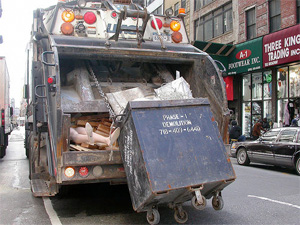See a Pattern of Deadly Dump Trucks? Don’t Bother Federal Safety Officials
The driver of a private garbage truck ignored a bicyclist riding alongside and crushed him as the truck rounded the corner of Varick Avenue and Meserole Street in Bushwick last Wednesday evening, BushwickBK.com has reported, citing a preliminary NYPD investigation. According to police, the victim was Eling Rivera, 51, of East New York (a conflicting identification has surfaced in this Streetsblog comment thread).
 Photo: So Cal Metro/Flickr
Photo: So Cal Metro/FlickrNo definitive count is available, but Rivera’s death could well be the hundredth in which a garbage truck ran over a New York City pedestrian or cyclist over the past decade-and-a-half. Twenty-six such fatalities were recorded during a four-year period in the mid-1990s, a rate that equates to between six and seven per year, according to research I directed for Right Of Way in our 1999 report, Killed By Automobile [PDF, see pages 33-34].
With an average of 23.8 peds or cyclists killed per hundred million miles driven, garbage trucks had by far the highest fatality rate in the study, exceeding the all-vehicle average of 1.7 killed per hundred million miles by a factor of 14. Within the garbage truck category, the per-mile rate of killing pedestrians and cyclists was two-thirds higher for private haulers than for NYC Department of Sanitation trucks.
Six hours before Rivera was killed, operators of a Philadelphia garbage barge ignored a radio distress call from a stalled “duck boat” and rammed it, killing two tourists and sending 30 more into the Delaware River, the National Transportation Safety Board revealed yesterday.
Investigators from the NTSB, the federal agency chartered with determining causes of transportation accidents and formulating recommendations to improve transportation safety, are combing the Delaware River for clues in the duck boat-barge smashup. Yet none can be seen in Bushwick, just as no NTSB personnel have looked into any of the 100 or so other garbage truck-related pedestrian and cyclist fatalities dating to the mid-nineties.
The public associates the NTSB principally with investigating air crashes, and to a lesser extent with rail, marine and pipeline incidents. Yet the safety board’s charter (PDF, section 1131) also requires it to:
Investigate… and establish the facts, circumstances, and cause or probable cause of… any other accident related to the transportation of individuals or property when the Board decides [that] the accident involves problems of a recurring character. (emphasis added)
Citing this mandate, I wrote on behalf of Right of Way to NTSB chair Jim Hall in 1997, asking his agency to analyze what I said were “Two types of accident causation [that] are particularly recurrent in recent bicyclist fatalities in New York City: Dooring and interference from heavy trucks.” My letter was passed to the director of the USDOT Office of Environment, Energy and Safety, who dutifully cited ongoing agency programs while ignoring my plea to intervene in dooring and truck incidents. Further entreaties to Mr. Hall and other staffers at both USDOT and the NTSB were equally unavailing.
Yet even without federal support, municipalities are hardly powerless to reduce heavy truck dangers to cyclists and pedestrians. As the Portland (OR) Office of Transportation reports, fleets can be required to equip heavy trucks with “under-run” protective devices such as metal plates and guide bars to prevent cyclists from being dragged under the truck wheels. “Aspheric mirrors” can reduce truckers’ blind spots, without the visual distortion found in standard convex mirrors.
Proactive policing could summons operators for reckless maneuvers such as unsignaled turning, aggressive passing and rapid backing — practices that are relatively rare for NYC Sanitation drivers but appear endemic among less-regulated private haulers. Taking the long view, taxes on packaging and disposable products, along with policies encouraging families to avoid manufactured food in favor of fresh food, could shrink dump truck traffic at the source by reducing the need for garbage collection in the first place.
But don’t look for Jim Hall to help. Hall, who stepped down from NTSB in 2001, is being groomed by the cellular communications industry to be the public face of a new lobbying campaign to fend off federal restrictions on use of mobile devices by drivers (watch the PowerPoint). The campaign, billed as The Drive Coalition (Drivers for Responsibility, Innovation and Vehicle Education), suffered a setback last week when criticism by U.S. Transportation Secretary Ray LaHood forced them to shelve their rollout, according to Transportation Nation.
Perhaps safety campaigners should dust off that 1997 Right Of Way letter and send it to LaHood.





